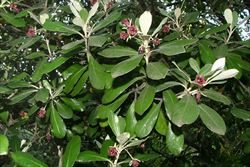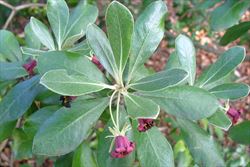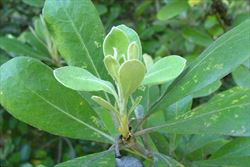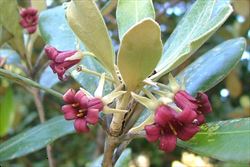Click on images to enlarge

habit (Photo: Sheldon Navie)

habit (Photo: Sheldon Navie)

older stem (Photo: Sheldon Navie)

leaves and flowers (Photo: Sheldon Navie)

whitish-coloured new growth (Photo: Sheldon Navie)

close-up of flowers (Photo: Sheldon Navie)

mature fruit with seeds (Photo: Sheldon Navie)
Scientific Name
Pittosporum crassifolium Banks & Sol. ex A. Cunn.
Family
Pittosporaceae
Common Names
dwarf karo, karo, karo pittosporum, stiff-leaf cheesewood, stiffleaf cheesewood, thick leaved box
Origin
Native to New Zealand (i.e. the North Island of New Zealand and the Kermadec Islands).
Naturalised Distribution
Naturalised in south-eastern Australia (i.e. in southern Victoria and the coastal districts of central New South Wales). Also sparingly naturalised in south-eastern South Australia and naturalised on Norfolk Island.
Naturalised overseas in south-western USA (i.e. California).
Notes
Karo (Pittosporum crassifolium) is regarded as an environmental weed in Victoria and New South Wales, and as a "sleeper weed" in other parts of southern Australia. This species is cultivated as a garden ornamental in wetter temperate regions, where it is often grown as a hedging plant. Its fruit are eaten by birds and other animals, which spread it into bushland areas.
Karo (Pittosporum crassifolium) is most important in Victoria, where it is seen as a potential threat to one or more vegetation formations. It was first recorded becoming naturalised in this state in 1984 and is now regarded as a potentially serious environmental weed. It appears on several local environmental weed lists in the southern parts of Victoria (e.g. in the Shire of Yarra Ranges, Mornington Peninsula Shire, Colac-Otway Shire and Sherbrooke Forest) and is listed as a "sleeper weed" in Frankston City.
In New South Wales, karo (Pittosporum crassifolium) is naturalised at Malabar Headland on the central coast and is listed as an environmental weed by the Blue Mountains City Council.

